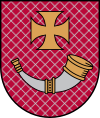Ventspils, Latvia
| Ventspils | |||
|---|---|---|---|
| Town | |||

Ventspils Castle, built by the Livonian Order, and converted into a prison in 1832.
|
|||
|
|||
| Location in Latvia | |||
| Coordinates: 57°23′26″N 21°34′24″E / 57.39056°N 21.57333°E | |||
| Country | |||
| Town rights | 1378 | ||
| Government | |||
| • Mayor | none | ||
| Area | |||
| • Total | 55.4 km2 (21.4 sq mi) | ||
| Population (1 January 2017) | |||
| • Total | 38,447 | ||
| • Density | 690/km2 (1,800/sq mi) | ||
| Time zone | EET (UTC+2) | ||
| • Summer (DST) | EEST (UTC+3) | ||
| Postal code | LV-36(01-21) | ||
| Calling code | (+371) 636 | ||
| Number of city council members | 13 | ||
| Website | www |
||
Ventspils (Latvian: [ˈvæntspils] (![]() listen); see other names) is a town in northwestern Latvia in the historical Courland region of Latvia, and is the sixth largest city in the country. At the beginning of 2017, Ventspils had a population of 39,286. It is situated on the Venta River and the Baltic Sea, and has an ice-free port. The city's name literally means "castle on the Venta", referring to the Livonian Order's castle built alongside the Venta River. Ventspils holds the national record for the highest temperature ever recorded in Latvia with 37.8 °C (100.0 °F) on 4 August 2014.
listen); see other names) is a town in northwestern Latvia in the historical Courland region of Latvia, and is the sixth largest city in the country. At the beginning of 2017, Ventspils had a population of 39,286. It is situated on the Venta River and the Baltic Sea, and has an ice-free port. The city's name literally means "castle on the Venta", referring to the Livonian Order's castle built alongside the Venta River. Ventspils holds the national record for the highest temperature ever recorded in Latvia with 37.8 °C (100.0 °F) on 4 August 2014.
Ventspils was historically known as Windau in German. A Russian name from the time of the Russian Empire was Виндава or Виндау although Вентспилс, a transliteration of Ventspils has been used since World War II. Some other names for the city include Livonian: Vǟnta and Polish: Windawa.
Ventspils developed around the Livonian Order Ventspils Castle, built along the Venta River. It was chartered in 1314 and became an important mercantile city of the Hanseatic League.
...
Wikipedia



